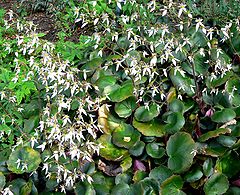Saxifraga stolonifera
| Saxifraga stolonifera subsp. var. | Mother of thousands, Strawberry begonia | |||||||||||||||||||||||||||||||||||||||||||||||||||||||
|---|---|---|---|---|---|---|---|---|---|---|---|---|---|---|---|---|---|---|---|---|---|---|---|---|---|---|---|---|---|---|---|---|---|---|---|---|---|---|---|---|---|---|---|---|---|---|---|---|---|---|---|---|---|---|---|---|

|
|
| ||||||||||||||||||||||||||||||||||||||||||||||||||||||
| ||||||||||||||||||||||||||||||||||||||||||||||||||||||||
Saxifraga stolonifera is a perennial flowering plant known by several common names, including Creeping Saxifrage, Strawberry Saxifrage, Creeping Rockfoil, the quite ambiguous "Aaron's beard", and Strawberry Begonia or Strawberry Geranium (it is neither a begonia nor a geranium). It is native to Asia but has been introduced to other continents, mainly for use as an ornamental. A popular garden flower, it has attractive white blossoms with distinctive pointed petals and bright yellow ovary. S. stolonifera also sees use as a houseplant. Its creeping green foliage makes a good groundcover. The plant spreads via threadlike stolon (runners), with plantlets taking root in the vicinity of the mother plant. It is hardy to USDA zone 5.
The foliage is occasionally used fresh or cooked in Japanese cuisine. It was also used as an herbal remedy in Classical Japan.
Cultivation
An evergreen Perennial growing to 0.15m by 0.3m.
It is hardy to zone 5 and is frost tender. It is in leaf all year, in flower from July to August.
The plant prefers light (sandy), medium (loamy) and heavy (clay) soils and can grow in heavy clay and nutritionally poor soils. The plant prefers acid, neutral and basic (alkaline) soils. It can grow in semi-shade (light woodland). It requires moist soil.
Prefers a cool position in a moist humus-rich soil[1]. Prefers an acid soil[200]. Thrives on heavy soils in the milder areas of the country[208]. Usually thrives in a poor soil with a northerly aspect[1]. Grows well in light woodland[200] or in a shady position in a rock garden. The plant is hardy to about -10°c[187]. The leaves and the flowers, however, are liable to be damaged by autumn frosts[200]. A very ornamental plant[1], it is sometimes grown as a house plant[200]. A polymorphic species[1], it is closely related to S. cortusifolia, differing in having runners[200].
Propagation
Seed - we have no information for this species but suggest sowing the seed in a cold frame in the spring. Surface sow, or only just cover the seed, and make sure that the compost does not dry out. Prick out the seedlings into individual pots when they are large enough to handle and grow them on in the greenhouse or cold frame for their first winter. Plant them out in late spring after the last expected frosts. Division in spring. Larger divisions can be planted out direct into their permanent positions. We have found it best to pot up the smaller divisions and grow them on in a lightly shaded position in a cold frame, planting them out once they are well established in the summer.
Pests and diseases
Varieties
Gallery
References
- Plants for a Future - creative commons text incorporated
External links
- w:Saxifraga stolonifera. Some of the material on this page may be from Wikipedia, under the Creative Commons license.
- Saxifraga stolonifera QR Code (Size 50, 100, 200, 500)



